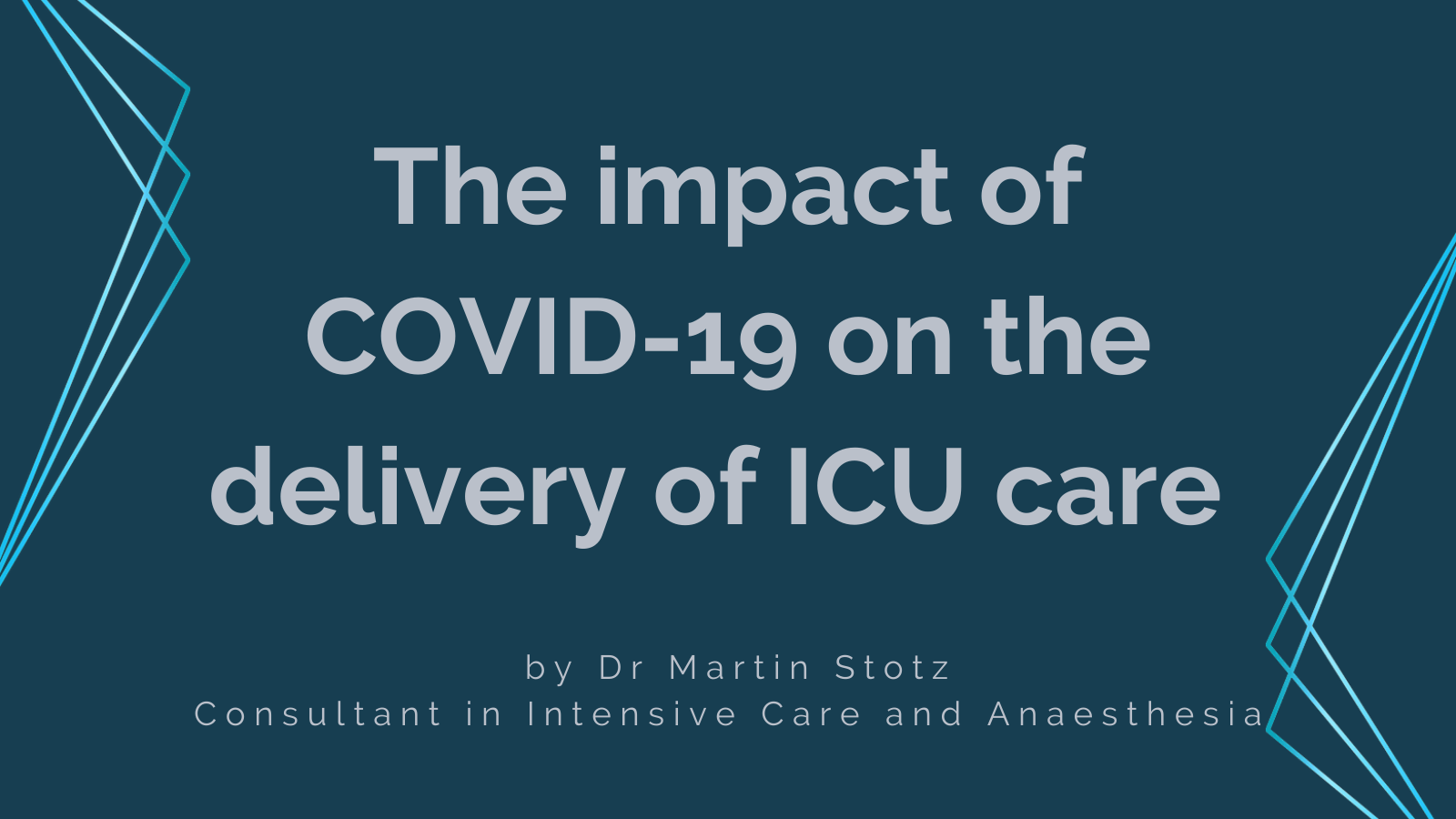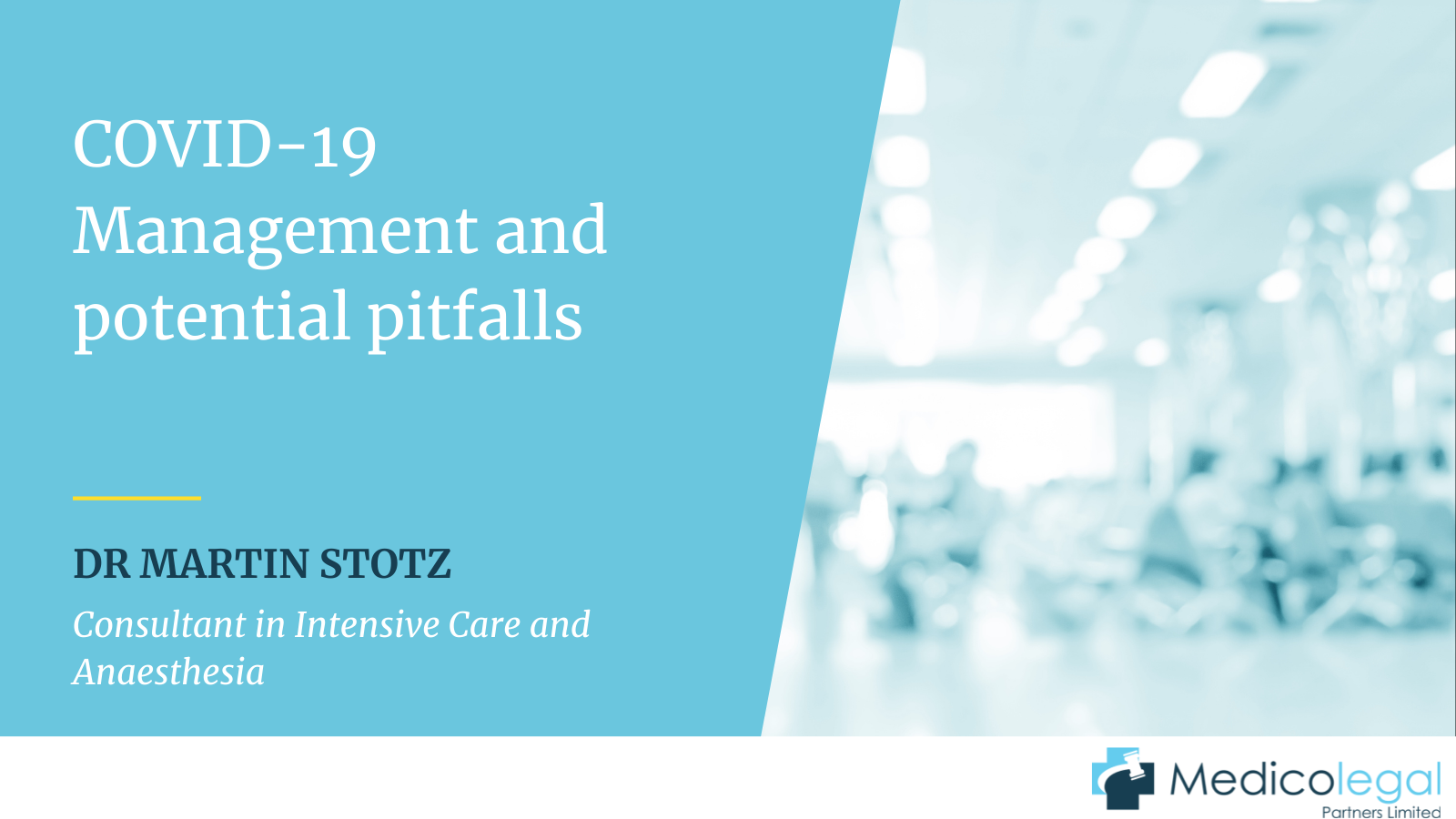The Impact of COVID-19 on the Delivery of ICU Care

The COVID-19 pandemic, caused by the SARS-COV-2 virus, has had an enormous impact on healthcare systems around the world. Understandably, intensive care unit (ICU) provision has seen the most significant effects and has had to adapt to cope with the unprecedented demand. Some of these changes will have implications for ICU facilities even when the pandemic is over and may provide the basis for future provision in the eventuality of another pandemic or major non-infectious event.
From the very start of the pandemic, it became clear that an increased ICU bed capacity would be required. In many UK hospitals, ICU and anaesthesia departments work closely together and often share staff (1). ICU expansion has been achieved by repurposing existing beds(such as theatre recovery areas) into COVID-19 wards and by the opening of additional facilities. However, expanding ICU provision has come at a cost to other areas of healthcare, as limited resources have been diverted away from them (1,2). Surgical activity has decreased markedly throughout the pandemic. While paediatric surgery has suffered the biggest impact, even emergency surgery has been reduced (1). Strain on ICU provision has almost certainly impacted on COVID-19 patients too, who have experienced higher mortality than might otherwise have been the case (2). This impact has not been uniform across the UK and may reflect not only regional temporal differences in infection peaks, but the baseline capacity and ability of different regions to expand services in response. In regions where there are lower numbers of ICU beds, relatively small rises in COVID-19 infection rates result in higher system stress (1).
The pandemic has also highlighted some issues with ICU design. Although single rooms increase patient privacy and reduce the likelihood of cross-patient contamination, when the patient:staff ratio is high, they can actually pose a higher risk to patients. Visibility of both the patient and equipment is reduced and alarms are more difficult to hear. Shared rooms also have the advantages of lower operational costs and a more efficient use of available staff and personal protective equipment (PPE) (2).
Inadequate staffing levels may lead to increased patient mortality, staff burnout and medical errors (2,3). In order to increase ICU capacity, staff have been redeployed from other areas of healthcare. For some specialties, such as anaesthesiology and emergency medicine, the skill set is fairly similar. However, additional resources are required to minimise the potential impact on the quality of care when patient management is provided by non-ICU doctors and nurses. This might include additional training along with the implementation of a tiered staffing model, in which experienced intensivists and intensive care nurses oversee non-accredited staff (2).
The medicolegal implications of non-ICU staff providing critical care have been addressed by the General Medical Council, which has assured doctors working outside their normal field of fair treatment should allegations of negligence arise (2). This allows for the uniquely pressured circumstances under which medical personnel find themselves currently working. However, it does not mean that clinicians working outside of their normal area will be not be held to the same standards of care as others in the same post. Clinicians still need to practice to a standard that is acceptable to a reasonable body of medical opinion and to document the decisions made and the rationale underpinning them (4).
The uncertainty surrounding the SARS-Cov-2 virus has also presented challenges in relation to obtaining informed consent. As it is a novel pathogen, there is limited evidence on which to base decisions. It is also unclear which risks should be deemed ‘material’, and precisely how the treatment pathway will progress. It is imperative that doctors are clear about what is and isn’t known, so that doctors and patients can decide whether any one treatment will be suitable. In these circumstances, documented evidence of the consent process is probably more important than ever (4).
As pressure on resources has increased, the possibility of having to ration life-saving care has become a major concern for many clinicians. However, rationing is already an integral part of healthcare provision, even in ICU. Here, the judgement as to whether a treatment is in the best interests of the patient or not already take into account the care that can be provided given the available resources, and the legality of such decisions has been repeatedly demonstrated in the courts (4). However, this process has become more focussed during the pandemic, and in response to this, guidelines for ICU triage have been drawn up, following existing UK guidelines. Thus, the aim remains to provide the greatest benefit to the greatest number of patients. The main criterion is the patient’s likelihood of survival and the reversibility of the underlying condition. Frailty and comorbidities are also assessed, and the patient’s wishes are considered too. All conditions have equal priority, and age is not a deciding factor (4–6), as this would amount to direct discrimination (4). Some institutions have introduced Clinical Decision Groups to assist clinicians independently with decision making in the admission process. There are no explicit criteria for discharge but the need to regularly review progress and stop when outcomes are not being achieved is acknowledged. One important recommendation is that all decisions regarding ICU admission and discharge are fully documented (5,6).
One aspect of care provision that has been severely affected by the COVID-19 pandemic is the principle of family-centred care, in which the patient’s family members are involved as much as possible. However, infection control measures including lockdowns, social distancing and visiting restrictions have resulted in a lack of access to the medical team. This has affected the relationship between staff and family members (2,3). Furthermore, it interferes with the legal rights of both the patient and their family. The presence of a family member is particularly important for children and vulnerable adults, where relatives may need to make decisions regarding treatment on the patient’s behalf. In an effort to prevent legal challenges, hospitals need to demonstrate that the aim of health protection outweighs the interference with an individual’s rights. Policies granting exceptions for children, vulnerable patients, birth partners and patients receiving end-of-life care are more likely to be acceptable than blanket bans on all visitors (4). New initiatives, such as more frequent telephone communication, web-based family conferences and video calls with patients who are well enough all help to involve family members (2,4). However, face-to-face communication remains the ideal and should be re-implemented as soon as possible (2).
Many ICU staff have reported psychological effects from working through the COVID-19 pandemic. These have resulted from the hugely increased workload, the belief that patient care has been compromised by the overwhelming demand on healthcare services, the high risk of catching the virus, and high subsequent death toll, among staff and the frequent relaying of bad news to relatives (1–3,6). Decisions about who is admitted to ICU and who isn’t depend on moral and cultural judgements, even when they are presented as clinical judgements defined by objective criteria (6). Furthermore, these pressures have occurred in tandem with a reduction in the support channels normally available – for many staff, leave has been cancelled and contact with their families is reduced (2,3). Thus, there is an urgent need to identify and implement interventions to support staff and reduce the psychological burden of the pandemic on healthcare workers (3).
Clearly, for anyone working within an ICU ward made up of COVID-19 patients, there is a high risk of infection. This has been demonstrated by the fact that healthcare workers make up about 10% of cases at any one time (2). Losses due to sickness, self-isolation and quarantine have resulted in as many as one-third of ICU staff being unavailable (1). Furthermore, the fatality rate in health care workers has been high (7). This has increased the pressure on available resources and staff morale. As well as vaccination against the SARS-Cov-2 virus, the implementation of infection prevention measures such as the provision of adequate PPE, the complete segregation of teams and social distancing of individuals within those teams should help to protect staff and reduce these pressures (2).
Some of the changes to ICU provision are likely to continue even when the pandemic is over. The overall delivery of critical care must contain an effective surge response, which includes reserves of PPE, ICU devices, consumables and drugs, effective supply chains and utilisation guidelines. Staffing models should allow for fluctuations in demand, so that surges in patient numbers can be accommodated (2). The physical and psychological welfare of staff must also be carefully considered (1). The COVID-19 pandemic has resulted in severe challenges to healthcare systems, and while it may have redefined what is achievable, adaptations have successfully overcome many issues and should continue to do so in the post-pandemic recovery phase.
About our expert
Dr Martin Stotz is a Consultant in Intensive Care and Anaesthesia at St Mary’s Hospital in London, where he leads a multi-disciplinary team. For the past 18 months Dr Stotz has been working within Intensive Care treating patients with COVID-19. He has a thorough knowledge of the treatment options and guidelines that were developed and distributed by the NHS as the medical community’s knowledge of the virus progressed.
References:
- Kursumovic E, Cook TM, Vindrola-Padros C, Kane AD, Armstrong RA, Waite O, et al. The impact of COVID-19 on anaesthesia and critical care services in the UK: a serial service evaluation*. Anaesthesia. 2021;
- Arabi YM, Azoulay E, Al-Dorzi HM, Phua J, Salluh J, Binnie A, et al. How the COVID-19 pandemic will change the future of critical care. Intensive Care Med. 2021;47:282–91.
- Cristine Troglio da Silva F, Parente Barbosa C. The impact of the COVID-19 pandemic in an intensive care unit (ICU): Psychiatric symptoms in healthcare professionals. Prog Neuropsychopharmacol Biol Psychiatry. 2021;110:110299.
- Coghlan N, Archard D, Sipanoun P, Hayes T, Baharlo B. COVID-19: legal implications for critical care. Anaesthesia. 2020;75:1517–28.
- NICE. COVID-19 rapid guideline: managing COVID-19 [Internet]. 2021 [cited 2021 Jul 22]. p. 78. Available from: https://www.nice.org.uk/guidance/ng191
- Tyrrell CSB, Mytton OT, Gentry S V, Thomas-Meyer M, Lee J, Allen Y, et al. Managing intensive care admissions when there are not enough beds during the COVID-19 pandemic: a systematic review State of the art review. Thorax. 2020;76:302–12.
- Up the line to death: covid-19 has revealed a mortal betrayal of the world’s healthcare workers – The BMJ [Internet]. [cited 2021 Jul 28]. Available from: https://blogs.bmj.com/bmj/2021/01/29/up-the-line-to-death-covid-19-has-revealed-a-mortal-betrayal-of-the-worlds-healthcare-workers/


